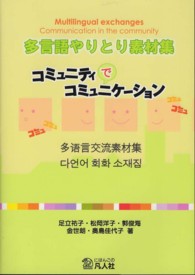- ホーム
- > 洋書
- > 英文書
- > Science / Mathematics
Full Description
Comprehensive overview of the principles, theories, and techniques behind deep learning-enabled semantic communications
Deep Learning Enabled Semantic Communications explores the synergy between deep learning and semantic communication, particularly in the context of advancing 6G networks. It provides a focused introduction to the subject, systematically covering deep learning-enabled semantic communication systems and task-oriented semantic transmission paradigms in wireless communication.
The book reviews various aspects of semantic communications, including information theory, multimodal technologies, semantic noise, and semantic sensing. It explores cutting-edge semantic communication architectures, highlighting their advantages over traditional approaches and their potential to drive the future of intelligent information industry. The book also details applications of deep learning-based semantic communication systems across various sources, including text, speech, images, and videos, comprehensively addressing system design, performance optimization, and measurement metrics.
The book is divided into eight main parts, which cover foundational knowledge, system design, multimodal and multitask-oriented semantic communication systems, joint semantic sensing and sampling, semantic noise suppression, and generative AI enabled systems.
Written by a diverse group of experts in academia and research institutions, Deep Learning Enabled Semantic Communications includes information on:
Fundamental knowledge about the deep learning and semantic communications, including the history, neural networks, and semantic information theory
Compression of multimodal inputs, extraction of global semantic information, and the design of neural networks to boost the capability of handling lengthy speech
Incorporation of different sources to extract semantic features and serve diverse intelligent tasks at the receiver
Introduction of semantic impairments in communications to uncover how to design robust systems
Joint design of data sampling, compression, and coding schemes under the guidance of semantic information
Framework of generative semantic communications to detail the principles of incorporating generative models into semantic communications
Deep Learning Enabled Semantic Communications is an essential learning resource and reference for graduate and undergraduate students pursuing degrees in wireless communications, signal processing, or deep learning as well as engineers in the telecommunications and IT industries focusing on wireless communication techniques.
Contents
Foreword ix
Preface xi
Acknowledgments xv
Acronyms xvii
Notations xxi
1 Introduction 1
1.1 Conventional Communications vs. Semantic Communications 2
1.1.1 Three-Level Communications . . . . . . . . . . . . . 2
1.1.2 History of Semantic Communications . . . . . . . . . 5
1.2 Introducing Deep Learning to Semantic Communications . . . . 6
1.2.1 Deep Learning Basics . . . . . . . . . . . . . . . . . . 6
1.2.2 Deep Learning Enabled Semantic Communications . 17
1.3 Semantic Communications for Further Networks . . . . . . . . . 20
2 Semantic Information Theory 31
2.1 Semantic Entropy . . . . . . . . . . . . . . . . . . . . . . . . . . . 31
2.1.1 Logical Probability-based . . . . . . . . . . . . . . . . 32
2.1.2 Synonymous mapping-based . . . . . . . . . . . . . . 34
2.1.3 Fuzzy Theory-based . . . . . . . . . . . . . . . . . . . 37
2.1.4 Task-based . . . . . . . . . . . . . . . . . . . . . . . . 38
2.2 Semantic Channel Capacity . . . . . . . . . . . . . . . . . . . . . 38
2.2.1 Logical Probability-based . . . . . . . . . . . . . . . . 39
2.2.2 Sympuous Mapping based . . . . . . . . . . . . . . . 40
2.3 Semantic Source Coding Theorem . . . . . . . . . . . . . . . . . 41
2.3.1 Logical Probability-based . . . . . . . . . . . . . . . . 42
2.3.2 Sympuous Mapping-based . . . . . . . . . . . . . . . 43
2.4 Semantic Channel Coding Theorem . . . . . . . . . . . . . . . . 44
2.4.1 Logical Probability-based . . . . . . . . . . . . . . . 44
2.4.2 Synonymous Mapping-based . . . . . . . . . . . . . 44
2.5 Information Bottleneck . . . . . . . . . . . . . . . . . . . . . . . . 45
2.5.1 Classical Information Bottleneck . . . . . . . . . . . . 45
2.5.2 Knowledge Collision based Information Bottleneck . 47
3 Joint Semantic-Channel Coding for Source Reconstruction 51
3.1 Semantic Communications for Text . . . . . . . . . . . . . . . . 52
3.1.1 Joint Semantic-Channel Coding for Text . . . . . . . 54
3.2 Semantic Communications for Speech . . . . . . . . . . . . . . . 58
3.2.1 Joint Semantic-Channel Coding for Speech . . . . . 60
3.3 Semantic Communications for Image . . . . . . . . . . . . . . . . 64
3.3.1 Joint Semantic-Channel Coding for Image . . . . . . 66
3.4 Performance Metrics . . . . . . . . . . . . . . . . . . . . . . . . . 71
3.4.1 Performance Metrics for Text Accuracy . . . . . . . 71
3.4.2 Performance Metrics for Speech Quality . . . . . . . 74
3.4.3 Performance Metrics for Image Quality . . . . . . . . 74
4 Task-Oriented Semantic Communications 85
4.1 Single-Modal Task-Oriented Semantic Communications . . . . . 86
4.1.1 Semantic Communications for Machine Translation 86
4.1.2 Semantic Communications for Speech Recognition and Synthesis . . . . . . . . . . . . . . . . . . . . . . . 91
4.2 Multimodal Task-Oriented Semantic Communications . . . . . . 104
4.2.1 Semantic Communication Systems for Visual Question Answering . . . . . . . . . . . . . . . . . . . . . . 104
5 Joint Sensing and Semantic Communications 115
5.1 Introduction and Framework of Joint Sampling and Coding . . 116
5.2 Joint Semantic Sampling and Coding for Image . . . . . . . . . 119
5.2.1 Semantic-aware Image Compressed Sensing . . . . . 120
5.2.2 Adaptive Sampling and Semantic-Channel Coding . 127
5.3 Joint Semantic Sampling and Coding for Video . . . . . . . . . 135
5.3.1 Semantic-based Video Sampling and Reconstruction 137
6 Semantic Impairments in Communications 145
6.1 JSCC Framework with Semantic Impairments . . . . . . . . . . 146
6.2 Source Semantic Impairments Suppression . . . . . . . . . . . . 149
6.2.1 Robust Semantic Communications for Text . . . . . 149
6.2.2 Robust Semantic Communications for Speech . . . . 157
6.2.3 Robust Semantic Communications for Image . . . . 165
6.3 Knowledge Base Semantic Impairments Suppression . . . . . . . 177
6.3.1 Robust Semantic Knowledge Base . . . . . . . . . . 178
7 Generative AI Enabled Semantic Communications 191
7.1 Introducing Generative Models to Semantic Communications . 191
7.2 Framework of Generative Semantic Communications . . . . . . 195
7.2.1 Main Components of Generative Semantic Communication System . . . . . . . . . . . . . . . . . . . . . 197
7.2.2 Key Interactions and Processes . . . . . . . . . . . . 201
7.3 Demonstration of Generative Semantic Communication for Video Conferencing . . . . . . . . . . . . . . . . . . . . . . . . . . . . . . 203
7.4 Applications of Semantic Communications in Other Scenarios . 206
7.4.1 Immersive Communications . . . . . . . . . . . . . . 206
7.4.2 Autonomous Driving . . . . . . . . . . . . . . . . . . 208
7.4.3 Smart Cities . . . . . . . . . . . . . . . . . . . . . . . 209
7.4.4 Satellite Networks . . . . . . . . . . . . . . . . . . . . 210
8 Conclusions and Challenges 217







